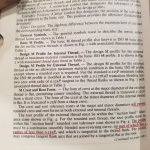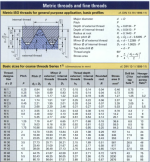This deal about the external minor diameter limits has been bugging me.
Here is a quote from ISO 965-1 regarding minor diameter:
"External threads on fasteners of property classes below 8.8 should
preferably conform to the requirements stated above. This is particularly important for fasteners or other screwed connections which are subjected to fatigue or impact.
However, there are in principle no restrictions other than that the maximum minor diameter, d3 max, of the external thread shall be less than the minimum minor diameter of the Go-gauges according to ISO 1502."
And here is a link to ISO 965-1. The quote above is from page 14:
So, by strict reading of the specification, unless the thread needs to be above property class 8.8, or is subjected to fatigue or impact, the thread root may be sharp. However, the spec also states this is not preferable.
Also, on page 14 the minimum allowable radii for threads above class 8.8 is specified as .125P.
I interpret this to mean there is some wiggle room regarding the minor diameter/root radius question. The rub is to defend your position you need to know the grade of the fastener and/or it's intended use. To err on the safe side, conform to the minor diameter and root radius limits. For low duty applications you can use less than a .125P root radius and the thread will still conform to ISO 965-1, even though it is not preferable to do so.
If you use full a profile insert this all becomes automatic. That is as long as the insert itself is manufactured correctly!
To speak more the the OPs question, It is interesting many insert manufactures offer multi-pitch threading inserts meant to be suitable for more than one metric pitch. The inserts are so sharp they will undercut the published minor diameter limits for the larger pitches they are intended to cut. Even if you maintain the minor dia. limits and widen the thread space to hit the pitch diameter, the radius will be under .125P. These multi-pitch inserts may not be the best thing to keep on hand if you need to conform to the minor diameter limits.







